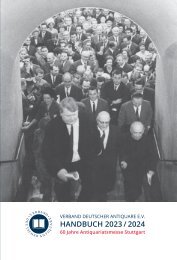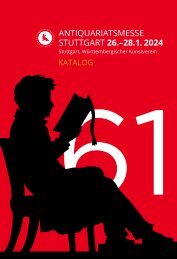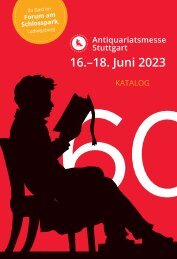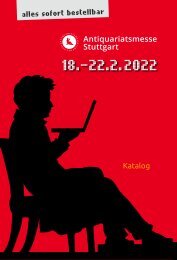Antiquariatsmesse Stuttgart 2021 - Katalog
Katalog zur Antiquariatsmesse Stuttgart 2021: Die Antiquariatsmesse Stuttgart als größtes Schaufenster für wertvolle Objekte des Antiquariats- und Graphikhandels in Deutschland findet in diesem Jahr in ungewohnter Form statt. Da eine Präsenzmesse nicht stattfinden kann, haben sich 76 Kollegen aus Deutschland, Großbritannien, Österreich, Frankreich, der Schweiz, den Niederlanden, den Vereinigten Staaten und aus Australien zusammengefunden, um einen Katalog für die Messe zu erstellen und gleichzeitig ein Angebot für eine virtuelle Messe zusammengetragen. Der Katalog wird am 7. Januar 2021 an interessierte Kunden verschickt, die virtuelle Messe öffnet ihre „digitalen Pforten“ am 29. Januar 2021 um 12.00 Uhr unter www.antiquariatsmesse-stuttgart.de
Katalog zur Antiquariatsmesse Stuttgart 2021: Die Antiquariatsmesse Stuttgart als größtes Schaufenster für wertvolle Objekte des Antiquariats- und Graphikhandels in Deutschland findet in diesem Jahr in ungewohnter Form statt. Da eine Präsenzmesse nicht stattfinden kann, haben sich 76 Kollegen aus Deutschland, Großbritannien, Österreich, Frankreich, der Schweiz, den Niederlanden, den Vereinigten Staaten und aus Australien zusammengefunden, um einen Katalog für die Messe zu erstellen und gleichzeitig ein Angebot für eine virtuelle Messe zusammengetragen.
Der Katalog wird am 7. Januar 2021 an interessierte Kunden verschickt, die virtuelle Messe öffnet ihre „digitalen Pforten“ am 29. Januar 2021 um 12.00 Uhr unter www.antiquariatsmesse-stuttgart.de
Erfolgreiche ePaper selbst erstellen
Machen Sie aus Ihren PDF Publikationen ein blätterbares Flipbook mit unserer einzigartigen Google optimierten e-Paper Software.
mit Beschreibungen“. Apart from this he illustrated a
great number of the finest natural history works published
at that period in South Germany.
Added to the series are: The original backcovers bound
in brown half morocco of all the 110 parts with the
printed names of the insects contained in each part.
The „Catalogus systematicus“ by Panzer of parts 1–108
„Index systematicus methodo Fabriciana“, Nürnberg
1793–1809. Saunders, E. Index to Panzer’s Fauna Insectorum
Germaniae. London 1888. Index Entomologicus
sistens insectorum species in G. W. Panzeri
Fauna Insectorum Germanica … Pars I. Eleutherata.
Norimbergiae 1813. Panzer, G. W. Kritische Revision
der Insektenfauna Deutschlands nach dem System
bearbeitet. I-XCVI Heft. Nürnberg 1805.
Nissen ZBI, 3084; Junk Rara II, p. 141.
Weinmann, J. W. Phytanthoza Iconographia,
sive conspectus aliquot millium, tam indigenarum
quam exoticarum, ex quatuor mundi partibus …
plantarum, arborum, fruticum, florum, fructuum,
fungorum, &c. [German title:] Phythanthoza
Iconographia, oder eigentliche Vorstellung etlicher
Tausend so wohl einheimisch- als ausländischer aus
allen vier Welt-Theilen, in Verlauf vieler Jahr mit
unermüdetem Fleisz … Pflanzen, Bäume, Stauden,
Kräuter, Blumen, Früchte und Schwämme … Regensburg,
H. Lentzen [vol 4: H. G. Neubauer],
1737–45. 4 volumes and 1 index volume. Folio
(382 × 250 mm). With four engraved titles in red
and black, one mezzotint frontispiece and two mezzotint
portraits, and 1025 (a few double-page) engraved
plates, some in mezzotint, the etched plates
hand-coloured, the mezzotints printed in colours
and finished by hand. Contemporary uniform calf,
richly gilt decorated spines in 7 compartments with
red gilt lettered label, sides with gilt ornamented
border and gilt corner pieces. € 120000,–
First edition. A very fine copy bound in a very attractive
contemporary German binding. Described by the
Hunt catalogue as the first botanical book to utilise
colour-printed mezzotint successfully. It also contains
Georg Dionysus Ehret’s first published botanical illustrations
(although unsigned). Ehret served his apprenticeship
as a botanical draughtsman under Weinmann
who exploited him mercilessly, paying him a pittance
for several hundred drawings he did for the „Phythanthoza“.
This led to a falling out between the two, which
is perhaps why Ehret is nowhere acknowledged in the
book. His drawings were engraved by Bartholomäus
Seuter, Johann Ridinger and, in the later volumes, Johann
Jakob Haid, who also engraved Ehret’s plates for
Trew’s „Plantae selectae“. Weinmann (1683–1741) was
a Regensburg apothecary who organised this massive
publishing project. It was financed by Seuter, one of the
engravers. The text for the first twenty-five plates was
written by Johann Georg Nicolaus Dieterichs (1681–
1737), who was succeeded by his son Ludwig Michael
(1716–1747), and the work was completed after Weinmann’s
death by Ambrosius Karl Bieler (1693–1747).
„The mezzotint process used [here] had been invented
by Johann Teyler in the Netherlands around 1688. As
practised here by Bartholomäus Seuter (1678–1754)
and Johann Elias Ridinger (1698–1767), it was really
a combination of etching and mezzotint, which made
possible delicate lines and a very fine grain. The addition
of handtinting brought about unusual and subtle
effects. Some of the best work was done in later volumes
by Johann Jakob Haid (1704–1767), who also provides
portraits of Weinmann and Bieler“ (Hunt catalogue vol.
II part II p. 160). „373 plates are signed S for Seuter and
273 plates signed H for Haid. The plates are after originals
by Ehret, N. Asamin, and others, although none
is so marked on the plate“ (Johnston). A mint copy
without the usual foxing and one of the finest copies
we have seen of this rare work.
Dunthorne 327; Great flower books p. 80; see Hunt
494; Johnston 388; Nissen BBI, 2126; Stafleu and
Cowan 17050. – Siehe Abbildung auf Tafel 8.
Zenker, J. K., Schlechtenthal, D. F. L. & Langethal,
C. E. Flora von Thüringen … Herausgegeben
von Prof. Dr. Zenker, Prof. Dr. v. Schlechtendal und
Prof. Dr. Langethal, die Originalzeichnungen gefertigt
von Dr. E. Schenk. Jena, Friedrich Mauke, 1855.
144 parts, forming 12 volumes. Small-8vo (168 × 95
mm). With 1444 (printed on 1440 leaves) very fine
hand-coloured engraved plates and descriptive text.
Contemporary green half morocco, richly gilt decorated
spines. € 7500,–
A fine uniformly bound copy of noble provenance,
old library stamp with crown and coat of arms on
title-page. The work was published from 1836–1855.
The present issue is the definitive issue of 1855 where
the plates and text were arranged in systematic order
and indices were added. It is one of the rarest and most
beautifully produced regional floras of Germany. Complete
copies are rare and W. Junk in the 1916 catalogue
describes the work as being „sehr selten“. The first
volume by J. C. Zenker, volumes 2–3 by D. F. L. von
Schlechtendal, and volumes 4–12 by von Schlechtendal
and L. E. Langethal.
Stafleu & Cowan, 18.637; Nissen BBI, 2197.
131






